
7 Eco-Friendly Choices to Make for Your Garden
If you’re into gardening, and want to ensure yours is as eco-friendly as you can make it, take a look at the seven tips we’ve gathered for you here. Some of them will be easier to implement than others, but all of them will ensure your garden is green in every sense of the word.
1. Go Completely Organic
Perhaps the most obvious choice you can make in your garden is to go 100% chemical-free. By creating a completely organic garden, you will be making a significant contribution to the good of the planet.
True, you will need to find a way to tackle pests, but there are many natural remedies you can use.
2. Collect Water
By harvesting your own water, you will minimize your reliance on your local water supply and make your garden more sustainable.
You can collect rainwater in barrels or tanks, but you can also collect water indoors by placing a bucket in your shower, for example, and using it to water the plants in your garden.
3. Reuse Garden Containers
To make yourself even more sustainable, consider using unique garden containers instead of store-bought ones. By reusing things you would have otherwise thrown away or recycled, you will keep these items away from landfills and save the energy required for their recycling.
You can use old pots, shoes, mugs: anything that may be chipped or damaged or you don’t really reach for as often as you used to.
4. Choose Your Plants Carefully
You can make your garden more eco-friendly by planting more perennials than annuals. By choosing plants well-adapted to your local soil, you can ensure they are more likely to survive and thrive for longer.
Think about your local ecosystem, as well. Plant some flowers that will help your local bees and other insects, then plant herbs you can use in your kitchen.
Don’t overplant a vegetable, if you know you may end up throwing some produce away. If you can’t eat everything you grow yourself, sell it at a local farmers’ market to make some extra money. Better yet, you can give it to friends and family or to your local shelters and food banks.
5. Have a Compost Bin
A compost bin is a great addition to any garden. It will cut down on the amount of trash you have to deal with and you can use your compost to make your garden grow more luscious.
Compost everything you can from your kitchen, as well as all garden waste.
6. Save the Seeds
Your flowers and veggies will produce seeds, which you should collect and store for next year’s planting.
Dry them and keep them in a cool place. You can get started with easier seeds, such as peppers, tomatoes, and peas. But, if you are a more experienced gardener, you can also preserve flower seeds and fruit seeds.
7. Use Sustainable Materials
Think about all the materials used in your garden. For example, you can make your own tags from recycled paper or sticks. You don’t have to buy them at the garden center.
Instead of making a purchase, you can create walls or fences from materials you already have on hand in the garden.
Stop to think whenever you need to add something to your garden. Do you have an item you can use for the task? Do you really need to buy something to deal with the issue?
Wrapping Up
Making your garden more eco-friendly and sustainable will not only be good for the planet — it will be a good challenge and hobby for you, too. It can be very fun to experiment with planting different kinds of local plants and figuring out how to make them thrive. Don’t give up. Keep working towards your green goal!




Post a comment